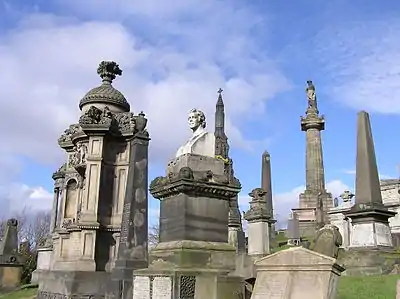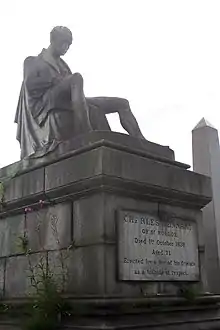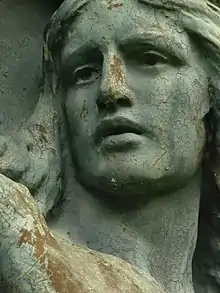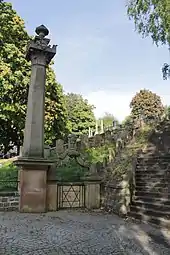| Glasgow Necropolis | |
|---|---|
 Monuments on the summit of the Glasgow Necropolis hill | |
| Details | |
| Established | 1832 |
| Location | |
| Country | Scotland |
| Coordinates | 55°51′44″N 4°14′00″W / 55.86217°N 4.23340°W |
| Type | Public |
| Size | 37 acres (15 ha) |
| No. of interments | 50,000 |
| Website | http://www.glasgownecropolis.org |
| Find a Grave | Glasgow Necropolis |
The Glasgow Necropolis is a Victorian cemetery in Glasgow, Scotland. It is on a low but very prominent hill to the east of Glasgow Cathedral (St. Mungo's Cathedral). Fifty thousand individuals have been buried here.[1] Typical for the period, only a small percentage are named on monuments and not every grave has a stone. Approximately 3,500 monuments exist here.
Background
Following the creation of Père Lachaise Cemetery in Paris a wave of pressure began for cemeteries in Britain. This required a change in the law to allow burial for profit. Previously the parish church held responsibility for burying the dead but there was a growing need for an alternative. Glasgow was one of the first to join this campaign, having a growing population, with fewer and fewer attending church. Led by Lord Provost James Ewing of Strathleven, the planning of the cemetery was started by the Merchants' House of Glasgow in 1831, in anticipation of a change in the law. The Cemeteries Act was passed in 1832 and Glasgow Necropolis officially opened in April 1833.[2] Just before this, in September 1832, a Jewish burial ground had been established in the north-west section of the land. This small area was declared "full" in 1851.
History

Pre-dating the cemetery, the statue of John Knox sitting on a column at the top of the hill, dates from 1825.
The first burials were in 1832 in the extreme north-east on the lowest ground and were exclusively for Jewish burials (see section below) Alexander Thomson designed a number of its tombs, and John Bryce and David Hamilton designed other architecture for the grounds.
The main entrance is approached by a bridge over what was then the Molendinar Burn. The bridge, which was designed by David Hamilton was completed in 1836. It became known as the "Bridge of Sighs" because it was part of the route of funeral processions (the name is an allusion to the Bridge of Sighs in Venice). The ornate gates (by both David and James Hamilton) were erected in 1838, restricting access onto the bridge.
Three modern memorials lie between the gates and the bridge: a memorial to still-born children; a memorial to the Korean War; and a memorial to Glaswegian recipients of the Victoria Cross.
Across the bridge the original scheme was to enter the area via a tunnel but this proved unviable. The ornate entrance of 1836 remains.
The cemetery, as most early Victorian cemeteries, is laid out as an informal park, lacking the formal grid layouts of later cemeteries. This layout is further enhanced by the complex topography. The cemetery's paths meander uphill towards the summit, where many of the larger monuments stand, clustered around the John Knox Monument.
The Glasgow Necropolis was described by James Stevens Curl as "literally a city of the dead". Glasgow native Billy Connolly has said: "Glasgow's a bit like Nashville, Tennessee: it doesn't care much for the living, but it really looks after the dead."[3]
Notable statues and sculptures


| Tomb/mausoleum | Statue/sculpture | Designer/artist | Year |
|---|---|---|---|
| Memorial column on summit of the hill | Monument to John Knox | Doric column by Thomas Hamilton and 12 ft (3.7 m) statue by William Warren (carved by Robert Forrest) | 1825 |
| Tomb of Mrs Lockhart | Sculpture | William Mossman | 1842 |
| Mausoleum of Major Archibald Douglas Monteath | Large tiered octagonal building of neo-Norman design | David Cousin | 1842 |
| Tomb of William Motherwell | Marble bust | James Fillans | 1851 |
| Tomb of actor-manager John Henry Alexander of the Theatre Royal | Scene representing stage and proscenium arch with flanking figures of "Tragedy" and "Comedy" (As of 2012, one figure is missing and the other is headless.) | James Hamilton, sculpted by Alexander Handyside Ritchie | 1851 |
| Houldsworth Mausoleum | Flanking angels and "Hope" and "Charity", with "Faith" visible inside the mausoleum | John Thomas | 1854 |
| Tomb of Charles Tennant | Seated marble figure of Charles Tennant of St Rollox | Patric Park | 1838 |
| Tomb of Walter Macfarlane, of the Saracen Foundry | Art-nouveau portrait panel | Bertram Mackennal of London | 1896 |
| Blackie publishing family tomb | Tomb slab | Talwin Morris (carved by J & G Mossman Ltd.) | 1910 |
| Monument to William McGavin | Statue by Robert Forrest | John Bryce | 1834 |
| Andrew McCall | Celtic cross to Andrew McCall | Charles Rennie Mackintosh | 1888 |
| Monument to Peter Lawrence | Statue of Life with a dashed torch | William Mossman | 1840 |
| Tomb to Mrs Margaret Montgomerie | Statues of "Hope" and "Resignation" | J G & W Mossman | 1856 |

Lords Provosts in the Necropolis

Other burials of note
- Alexander Allan, ship owner
- William Burns, historian
- Hector Clare Cameron
- Peter Clouston
- Charles Connell, shipbuilder
- Very Rev James Craik, moderator for 1863/4
- William Doleman, golfer
- John Gibb Dunlop, engineer
- Nathaniel Dunlop
- John Elder, shipbuilder, and his philanthropist wife Isabella Elder
- John Graham Gilbert, artist
- John Honeyman, architect
- John Inglis, shipbuilder
- James Jeffray, anatomist
- William Keddie, founder of the Scottish Sunday School system
- William Logan, temperance campaigner
- David MacBrayne
- James McCall, veterinary surgeon
- Very Rev James Duff MacCulloch
- Sir James MacFarlane (1857–1944), of MacFarlane Lang Biscuits[4]
- John Macgregor, shipbuilder
- David Prince Miller, magician and theatre owner
- William Miller, poet
- George Arthur Mitchell, mining engineer
- William Rae, firefighter
- Sir James Roberton
- Alexander Stephen, shipbuilder
- Peter Stewart, engineer – subject of a bronze sculpture by James Pittendrigh Macgillivray
- John Strang, writer
- John Templeton and James Stewart Templeton, each of James Templeton & Co carpet makers (the latter grave was originally coloured to look like a carpet)
- Charles S. P. Tennent and his brother Hugh Tennent and son Hugh Tennent all of Wellpark Brewery (the graves face the brewery)
- William Thomson, Lord Kelvin
- Rev Ralph Wardlaw
- James George Wilson
War graves
Glasgow Necropolis holds graves of 19 Commonwealth service personnel, 15 from World War I and 4 from World War II, that are registered and maintained by the Commonwealth War Graves Commission.[5] The first, and highest ranking, of those buried here is Lieutenant-General Sir James Moncrieff Grierson, who died in August 1914 in France and whose body was repatriated. His grave is in section Primus 38.[6]
Jewish section

As Jewish people were not allowed to be interred within Christian burial grounds, a small area outwith the boundary of the main cathedral graveyard was allocated to them. The ground contains 57 burials.[7]
Jewish burials took place here from 1832 to 1855, after which they were in the Eastern Necropolis.[8]
The cemetery is now part of the expanded Necropolis and due to its low location its significance is often unrecognised.
The Jewish cemetery was restored in 2015.[9]
More information about Jewish history in Scotland is available from the Scottish Jewish Archives Centre: https://www.sjac.org.uk/ .
Other memorials
See also
- Category:Burials at the Glasgow Necropolis
- Southern Necropolis, another large cemetery on the south side of the city
- Thomas Reid's tombstone
References
- ↑ Smith, Adam (2017). "Glasgow Cathedral and Necropolis". Glasgow The Postcard Collection. Amberley Publishing. ISBN 9781445667393. Retrieved 29 July 2022.
- ↑ "Glasgow Necropolis Heritage Trail" (pdf). Glasgow City Council.
- ↑ Billy Connolly's World Tour of Scotland (1994)
- ↑ "Sir James MacFarlane, of MacFarlane, Lang & Co. b. 20 Sep 1857 High Church, Glasgow, Lanarkshire, Scotland d. 26 Jan 1944 2 Cleveden Cres., Glasgow, Lanarkshire, Scotland: MacFarlane Clan & Families Genealogy". www.clanmacfarlanegenealogy.info.
- ↑ "Results". www.cwgc.org. Retrieved 27 February 2018.
- ↑ "Casualty".
- ↑ "Scottish Jewish Cemeteries". www.scottishjewishcemeteries.org.
- ↑ "GHBS". glasgowhebrewburialsociety.org.
- ↑ Gibson, Jennifer (6 August 2015). "Glasgow Necropolis Jewish cemetery restoration". Jewish Heritage Europe.
- ↑ William Wallace memorial - Canmore.org.uk